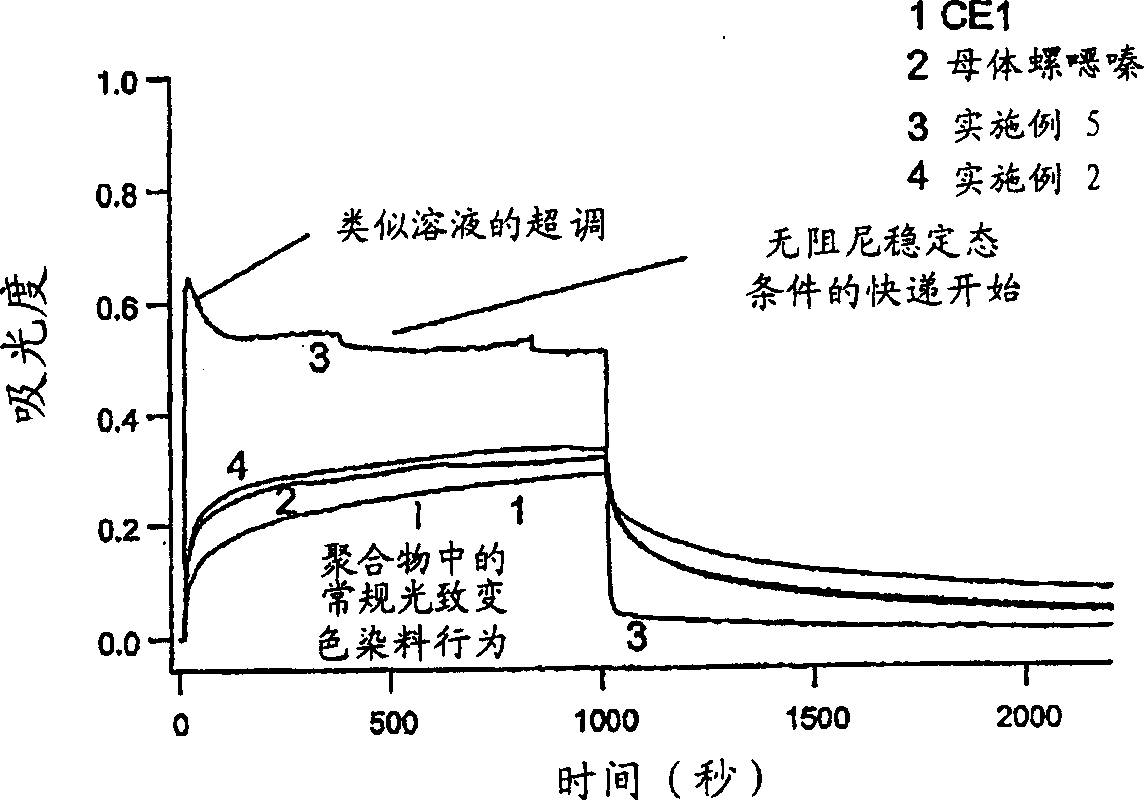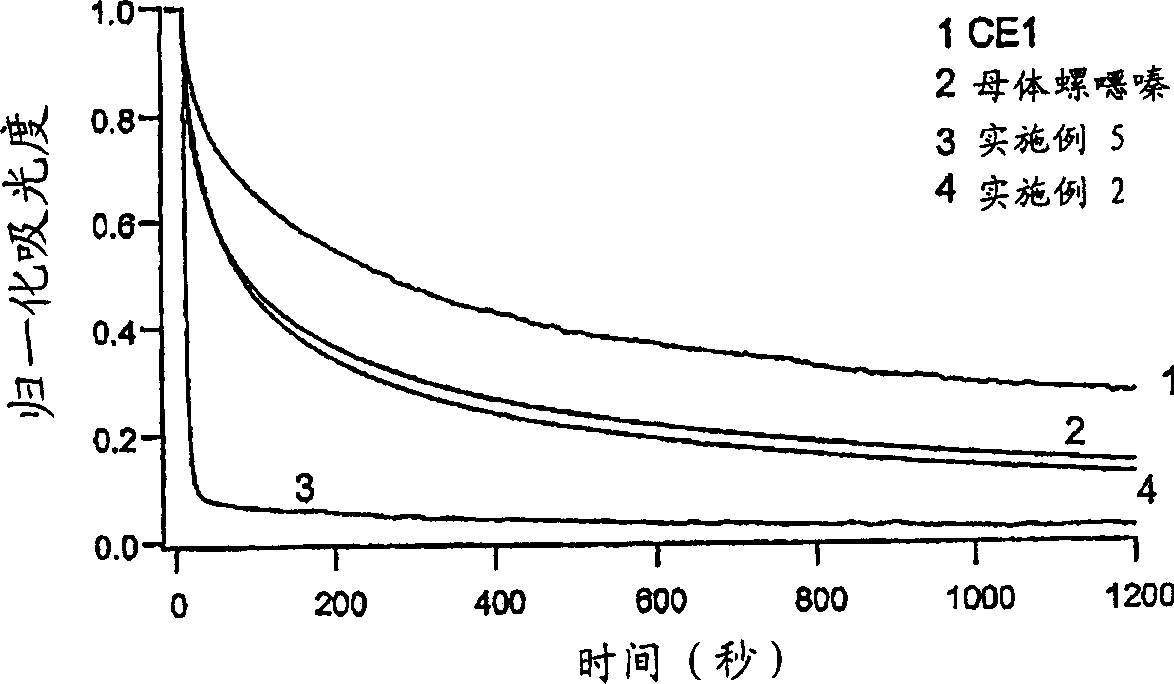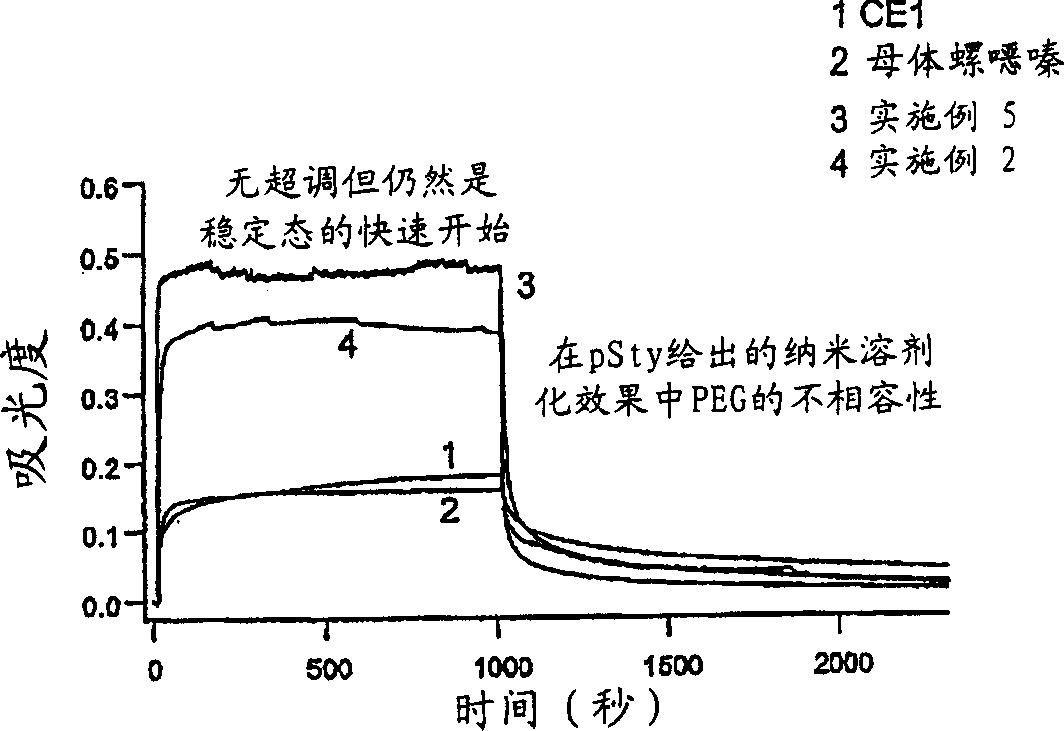Photochromic compositions and light transmissible articles
A photochromic and composition technology, applied in the direction of color-changing fluorescent materials, silicon organic compounds, radiation-absorbing coatings, etc., can solve the problems of reversible color change or low efficiency, short chemical degradation life and so on
- Summary
- Abstract
- Description
- Claims
- Application Information
AI Technical Summary
Problems solved by technology
Method used
Image
Examples
Embodiment 1
[0350] 9'-(PEG(350)-succinyl)-1,3,3-trimethylspiro[indoline-2,3'-[3h]naphthalene[2,1-b][1,4] Oxazine] (PEG(350)-suc-SOX)
[0351]
[0352] 9'-Hydroxy-1,3,3-trimethylspiro[indoline-2,3'-[3H]naphthalene[2,1-b][1,4]oxazine] (1.95g, 5.67mmol) and triethylamine (0.857g, 1.18mL, 8.5mmol) were added together in dichloromethane (30mL), then chlorosuccinic acid mono-PEG (350) ester (3.19g, 6.8 mmol) was added dropwise to the solution at room temperature under the protection of argon. When the reaction was complete, it was diluted and refined by washing with dichloromethane, washed with dilute sodium hydroxide, dilute HCl and brine, followed by final drying over magnesium sulfate to give a dark brown oil (4 g), which was purified by column chromatography , to give a brown oil. 1 H NMR (CDCl 3 )δ1.33(s, 6H, C(CH 3 ) 2 ), 2.75 (s, 3H, N-CH 3 ), 2.82 & 2.94 (multiplet, 4H, C=O-CH 2 CH 2 -C=O), 3.35(s, 3H, O-CH 3 ), 3.53 (multiplet, 2H, CH 2 -O-CH 3 ), 3.63 (s, PEG unit), 3.7...
Embodiment 2
[0354] 9'-(PEG(750)-succinyl)-1,3,3-trimethylspiro[indoline-2,3'-[3H]naphthalene[2,1-b][1,4] Oxazine] (PEG(750)-suc-SOX)
[0355]
[0356] 9'-(PEG(750)-succinyl)-1,3,3-trimethylspiro[indoline-2,3'-[3H]naphthalene[2,1-b][1,4] Oxazine] with 9'-(PEG(350)-succinyl)-1,3,3-trimethylspiro[indoline-2,3'-[3H]naphthalene[2,1-b] [1,4]Oxazine] was synthesized in the same manner, using chlorosuccinic acid mono-PEG (750) ester instead of chlorosuccinic acid mono-PEG (350) ester, thus obtaining a product yield of 76%. That 1 The H NMR spectrum appears to be consistent with 9'-(PEG(350)-succinyl)-1,3,3-trimethylspiro[indoline-2,3'-[3H]naphthalene[2,1-b ][1,4]oxazine], except that it has a larger singlet of one PEG unit at 3.63 ppm. 1 H NMR (CDCl 3 )δ1.33(s, 6H, C(CH 3 ) 2 ), 2.75 (s, 3H, N-CH 3 ), 2.82 & 2.94 (multiplet, 4H, C=O-CH 2 CH 2 -C=O), 3.35(s, 3H, O-CH 3 ), 3.53 (multiplet, 2H, CH 2 -O-CH 3 ), 3.63 (s, PEG unit), 3.71 (multiplet, 2H, CH 2 CH 2 O-C=O), 4.30 (multipl...
Embodiment 3
[0358] part (a)
[0359] 5,9'-Dihydroxy-1,3,3-trimethylspiro[indoline-2,3'-[3H]naphthalene[2,1-b][1,4]oxazine]
[0360]
[0361] 5-Hydroxy-1,2,3,3-tetramethylindolium iodide (1.65 g, 5.2 mmol) was dissolved in methanol (10 mL), and butanone (5 mL) and piperidine (0.5 mL) were added dropwise , let the solution stand. 2,7-Dihydroxy-1-nitrosonaphthalene (0.983 g) was then added and the solution was refluxed for 1 hour before it was stirred overnight at room temperature. The solvent was evaporated and the residue was chromatographed to give a dark blue product (300 mg 17%). 1 H NMR (DMSO-d 6 )δ1.20 & 1.27 (s, 3H, methyl), 2.57 (s, 3H, N-Me), 6.37-6.61 (multiple aromatic groups), 6.61-6.76 (multiple aromatic groups), 7.58-7.98 ( Multiple aryl groups), 8.80 (naphthyl aryl), 9.88 (naphthyl aryl) ppm.
[0362] part (b)
[0363] 5,9'-di(PEG(350)-succinyl)-1,3,3-trimethylspiro[induline-2,3'-[3H]naphthalene[2,1-b ][1,4]oxazine](bis PEG(350)-suc)+SOX)
[0364]
[0365] With ...
PUM
| Property | Measurement | Unit |
|---|---|---|
| glass transition temperature | aaaaa | aaaaa |
| glass transition temperature | aaaaa | aaaaa |
| diameter | aaaaa | aaaaa |
Abstract
Description
Claims
Application Information
 Login to View More
Login to View More - R&D
- Intellectual Property
- Life Sciences
- Materials
- Tech Scout
- Unparalleled Data Quality
- Higher Quality Content
- 60% Fewer Hallucinations
Browse by: Latest US Patents, China's latest patents, Technical Efficacy Thesaurus, Application Domain, Technology Topic, Popular Technical Reports.
© 2025 PatSnap. All rights reserved.Legal|Privacy policy|Modern Slavery Act Transparency Statement|Sitemap|About US| Contact US: help@patsnap.com



